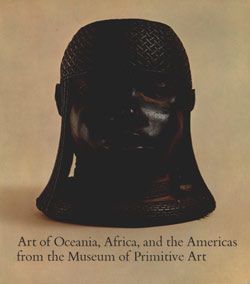Gold Dust Box (abamphruwa)
Not on view
This lidded brass box (abamphruwa) was cast to hold gold dust, the currency of the Asante Empire. The box takes the shape of a square cross; its flat lid is secured by an inner vertical ridge that fits into the opening of the box. The exterior of the box is plain. The top of the lid has bands of parallel lines at the tip of each of its projecting edges, and an overall pattern of raised registers of lines filled with x-shaped or zig-zag patterns. Sculpted in three dimensions, four slender quadrupeds—goats or rams—stand at the edges of the box, along with a fifth, larger animal at the center. Simply modeled, each animal is shaped to appear as if it were in motion. The flattened, triangular heads thrust forward from the bodies, the large domed eyes on the side followed closely behind by backwards facing ears. Thin tubes form the curved horns and tails, as well as the legs, which are bent at the knees and ankles. The box was likely made using the lost wax casting method, in which a model is created in wax, surrounded with a clay investiture that is then baked (allowing the wax to melt out), and then filled with molten metal. The box has an overall brass color, with some areas of darker patination or lighter highlights, likely the result of handling. While cast brass gold dust boxes are more common than those made of sheet metal in Akan art, examples with elaborate surface ornamentation and miniature sculptures on the lid—such as this work—are rarer.
While the exact meaning of the miniature animals on the lid of this box is not known, proverbs related to goats and rams abound in Akan culture. One such example is “If you overpower a ram, the male goat is of no consequence to you,” suggesting the role of respect in relationships between men of different status. (Appiah 2007, 234) The geometric pattern on the box may also be linked to another form of Akan expression called adinkra, a set of symbols that represent concepts or aphorisms. The x-shape contained in a box may allude to the adinkra symbol called “mframadan” (wind house), a symbol of fortitude.
Historically, only royals and members of their entourage could possess precious metals like locally mined gold (sika) and imported silver. Akan gold production likely began in the second half of the fifteenth century, yielding approximately fourteen million ounces of metal by 1900. Gold circulated in powdered form (sika futuro) as the currency of the Asante Empire and many of its neighbors until 1901; when not accumulated as a form of personal wealth, gold dust was melted down and cast into fashionable ornaments. Regalia—including woven textiles and elaborate gold ornaments—have been omnipresent aspects of Akan courtly life since at least the fifteenth century. Members of the royal goldsmiths' guild exclusively produced gold ornaments, including staffs, rings, and symbolic figures to attach to clothing or furniture. According to oral tradition, these highly skilled artists claimed ancestry from Fusu Kwabi, who supposedly descended from heaven in the 1400s to teach men how to work gold. They also produced elaborate sets of brass weights, scales, measuring spoons, and containers for the weighing and storage of gold dust. Smaller boxes such as this were known as abamphruwa, while larger storage vessels were called kuduo. Most sets contained two or three of the smaller boxes; as such, another box in the Met’s collection (1979.206.181a, b) is considered the pair to this example. Small boxes may also have doubled as weights, particularly when filled with metal filings to adjust their weight to meet the standard.
Kept in a pair of treasury bags known as futuo, sets of weights and related equipment were owned individually by most merchants and high-ranking individuals, each of whom used their personal weighing equipment to ensure a fair transaction. During each exchange, gold dust was placed on a scale using brass spoons and weighed with cast-brass weights of varying sizes. The Akan developed a system for weighing gold dust based on North African, Dutch, Portuguese, and local measures, resulting in precisely calibrated weights. Gold was not only a means of wealth and a way of displaying status, but also a spiritual substance. The shining metal was believed to be the earthly embodiment of the sun, and thus the force of life itself (kra).
Kristen Windmuller-Luna, 2016
Sylvan C. Coleman and Pam Coleman Memorial Fund Fellow in the Department of the Arts of Africa, Oceania, and the America
Further reading
Appiah, Peggy, Anthony Appiah, and Ivor Agyeman-Duah. Bu Me Be: Proverbs of the Akans. Oxfordshire, UK: Ayebia Clarke, 2007.
Cole, Herbert M., and Doran H. Ross. The Arts of Ghana. Los Angeles: Museum of Cultural History, 1977.
Garrard, Timothy F. Akan Weights and the Gold Trade. London: Longman, 1980.
Garrard, Timothy F. "The Akan of Ghana." In African Gold: Jewellry and Ornaments from Ghana, Cote D'Ivoire, Mali and Senegal in the Collection of the Gold of Africa, Barbier-Mueller Museum in Cape Town. New York/Munich: Prestel, 2011.
Ross, Doran H., Georg Eisner, and Leslie Jones. Royal Arts of the Akan: West African Gold in Museum Liaunig. Neuhaus/Suha: HL Museumverwaltung, 2009.
Wilks, Ivor. Forests of Gold: Essays on the Akan and the Kingdom of Asante. Athens: Ohio University Press, 1993.
Due to rights restrictions, this image cannot be enlarged, viewed at full screen, or downloaded.


